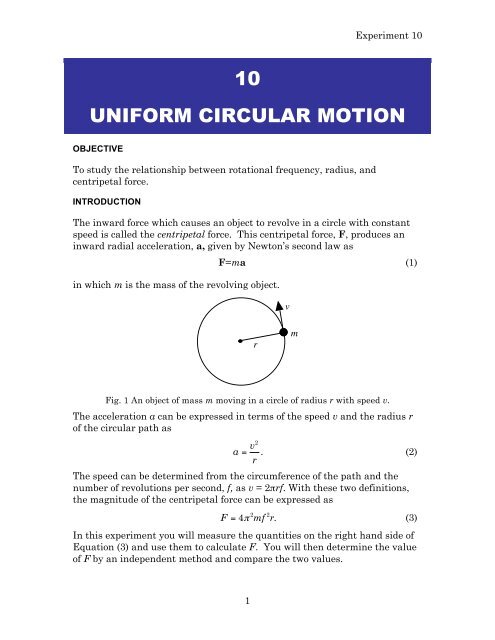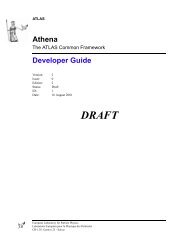10 UNIFORM CIRCULAR MOTION
10 UNIFORM CIRCULAR MOTION
10 UNIFORM CIRCULAR MOTION
You also want an ePaper? Increase the reach of your titles
YUMPU automatically turns print PDFs into web optimized ePapers that Google loves.
Experiment <strong>10</strong><br />
<strong>10</strong><br />
<strong>UNIFORM</strong> <strong>CIRCULAR</strong> <strong>MOTION</strong><br />
OBJECTIVE<br />
To study the relationship between rotational frequency, radius, and<br />
centripetal force.<br />
INTRODUCTION<br />
The inward force which causes an object to revolve in a circle with constant<br />
speed is called the centripetal force. This centripetal force, F, produces an<br />
inward radial acceleration, a, given by Newton’s second law as<br />
in which m is the mass of the revolving object.<br />
F=ma (1)<br />
v<br />
r<br />
m<br />
Fig. 1 An object of mass m moving in a circle of radius r with speed v.<br />
The acceleration a can be expressed in terms of the speed v and the radius r<br />
of the circular path as<br />
a = v2<br />
r . (2)<br />
The speed can be determined from the circumference of the path and the<br />
number of revolutions per second, f, as v = 2πrf. With these two definitions,<br />
the magnitude of the centripetal € force can be expressed as<br />
F = 4π 2 mf 2 r. (3)<br />
In this experiment you will measure the quantities on the right hand side of<br />
Equation (3) and use them to calculate F. You will then determine the value<br />
of F by an independent method € and compare the two values.<br />
1
Experiment <strong>10</strong><br />
ACTIVITY 1<br />
1. Detach the spring from the heavy mass (Fig. 2) allowing the mass<br />
to hang freely. Adjust the position of the cross-arm to the middle of<br />
its adjustable position. Clamp the cross-arm firmly.<br />
Heavy mass<br />
Indicator<br />
ACTIVITY 2<br />
Fig. 2. Circular motion apparatus.<br />
2. Move the radial indicator (the skinny vertical rod) so that it is<br />
directly below the point of the heavy mass. Clamp firmly into place.<br />
3. Determine the mass of the revolving heavy mass, m, with a<br />
laboratory balance. Record this measurement.<br />
4. Measure the radius of rotation, r, the distance from the center<br />
of the top of the radius indicator to the axis of the vertical shaft. To<br />
obtain this value add the radius of the shaft (0.625 cm) to the<br />
distance from the exterior of the shaft to the center of the top of the<br />
indicator post.<br />
5. Reattach the heavy mass to the spring that is connected to the<br />
shaft. Rotate the system by turning the knurled portion of the<br />
shaft. [The knurled portion of the shaft is the bumpy section.]<br />
6. With a little practice you should be able to keep the mass passing<br />
directly over the indicator and determine the frequency f. A piece of<br />
white paper located to provide a light background is helpful in<br />
seeing that the rotating mass passes exactly over the indicator.<br />
7. Use the stopwatch to time twenty or more revolutions. The value of<br />
f is given by the number of revolutions divided by the time in<br />
seconds. What are the units of frequency? Make two or more<br />
additional trials and average the results. Record the value<br />
obtained for f.<br />
2
Experiment <strong>10</strong><br />
ACTIVITY 3<br />
8. Calculate the centripetal force for the rotation using the average<br />
value of f. Record your results, showing all calculations.<br />
9. Measure the force necessary to pull the heavy mass out to the<br />
indicator by tying the string to the stationary heavy mass and<br />
extending it over the pulley (Fig. 3). Apply enough weight to the<br />
end of the string to stretch the spring out so that the heavy mass<br />
will again be directly over the indicator. What is the necessary<br />
weight? Remember that the weight hanger also has mass.<br />
Fig. 3. Measuring the force to stretch the spring.<br />
<strong>10</strong>. Using the weight determined in the previous step, calculate the<br />
static force. What is the relationship between the mass and<br />
the force?<br />
11. Compare the centripetal force to the static force by computing the<br />
percent difference.<br />
% difference =<br />
F centripetal<br />
− F static<br />
[ ] ×<strong>10</strong>0%<br />
1<br />
2 F centripetal + F static<br />
ACTIVITY 4<br />
ACTIVITY 5<br />
12. Repeat € Activities 2 and 3 for two other positions of the support arm<br />
so that a total of three different radii will be tried. Remember to<br />
detach the spring when making the adjustment for a new radial<br />
position for the heavy mass.<br />
13. Using your last trial as a starting point, describe what happens<br />
if you spin the heavy mass faster. How do the measured<br />
parameters (radius and frequency) change? Does the<br />
centripetal force go up or down? How can you tell?<br />
3
Experiment <strong>10</strong><br />
14. Describe what happens if you spin the weight slower. How do the<br />
measured parameters (radius and frequency) change? Does the<br />
centripetal force go up or down? How can you tell?<br />
4
Experiment <strong>10</strong><br />
Hand in these data sheets.<br />
Name ____________________<br />
<strong>UNIFORM</strong> <strong>CIRCULAR</strong> <strong>MOTION</strong><br />
DATA SHEETS<br />
ACTIVITY 1<br />
The mass of the bob hanging from the rotating rod is .<br />
ACTIVITY 2 & 3<br />
Radius = m.<br />
Run f (rev/s) Computed force<br />
Fcentripetal (N)<br />
Measured force<br />
Fstatic (N)<br />
1<br />
2<br />
3<br />
Average value<br />
% difference<br />
ACTIVITY 4 SECOND TRIAL<br />
Radius = m.<br />
Run f (rev/s) Computed force<br />
Fcentripetal (N)<br />
Measured force<br />
Fstatic (N)<br />
1<br />
2<br />
3<br />
Average value<br />
% difference<br />
5
Experiment <strong>10</strong><br />
ACTIVITY 4 THIRD TRIAL<br />
Radius = m.<br />
Run f (rev/s) Computed force<br />
Fcentripetal (N)<br />
1<br />
2<br />
3<br />
Average value<br />
% difference<br />
Measured force<br />
Fstatic (N)<br />
ACTIVITY 5<br />
What happens if you spin the heavy mass faster? How do the<br />
measured parameters (radius and frequency) change?<br />
Does the centripetal force go up or down?<br />
How can you tell?<br />
What happens if you spin the heavy mass slower? How do the<br />
measured parameters (radius and frequency) change?<br />
Does the centripetal force go up or down?<br />
How can you tell?<br />
6

















